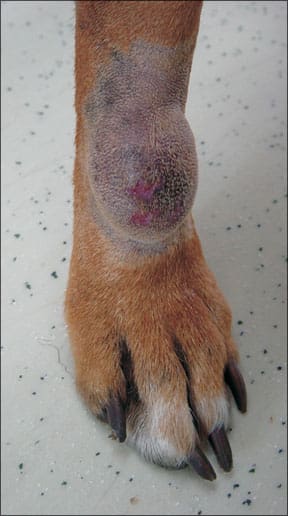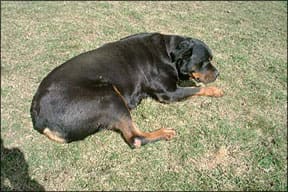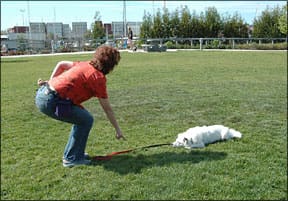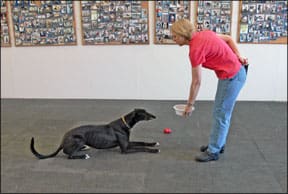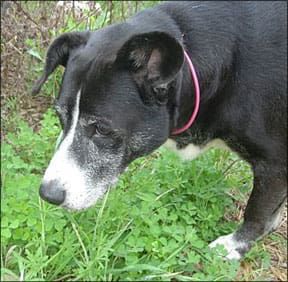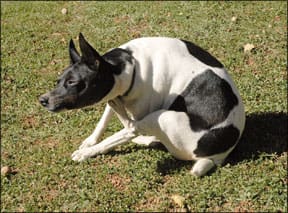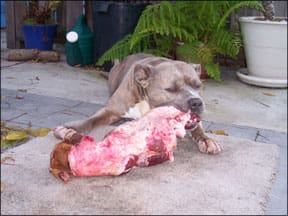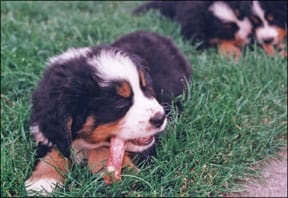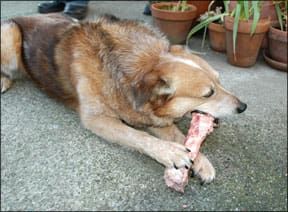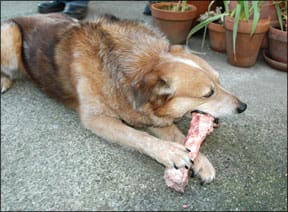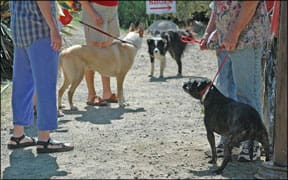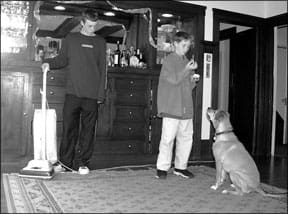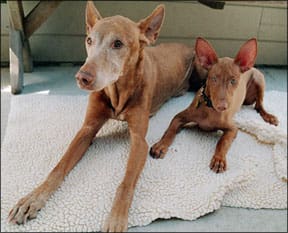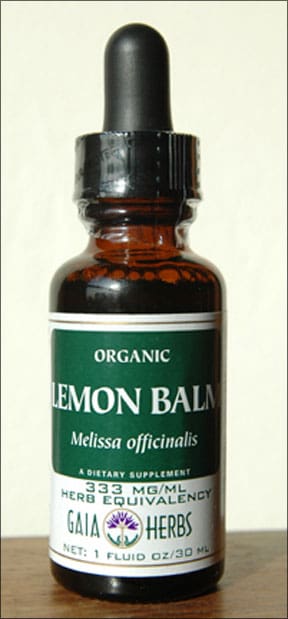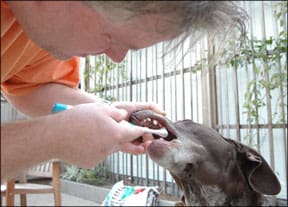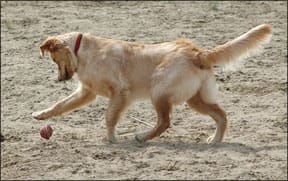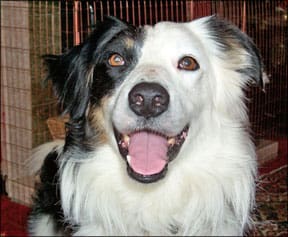MULTI-SPECIES HOUSEHOLD OVERVIEW
What you can do…
– Do some research before adding a new species to your family, so you can make adoption choices that have the greatest likelihood of success.
– Recruit friends and family to assist you in orchestrating careful introductions.
– If your animal companions already have undesirable associations with each other, commit to a training and behavior modification program to create peaceful relationships.
– Use fail-safe management protocols to protect everyone.
You’ve no doubt heard the phrase “fighting like cats and dogs.” As well-known as the saying is, it’s also an often inaccurate one. Millions of dog lovers share their hearts and homes with feline family members with nary a scratch between the species.
On the other paw, stories of dogs killing cats are fact, not fiction, and many unfortunate Rowdy Rovers have suffered ulcerated corneas, scratched nose leathers, and infected puncture wounds from Tough Tiggers who decided that “fight” was a better strategy than “flight.” What determines the difference between Fido and Fluffy amicably sharing the sofa and one or both ending up at the emergency clinic – or worse?
The media likes to play up stories about personality differences between “cat lovers” and “dog lovers,” but many of us are both. We may also fill our lives with one or more small animal companions including rabbits, rats, ferrets, guinea pigs, iguanas, fish, finches, macaws, and a multitude of other creatures. It’s our responsibility and obligation as their guardians to ensure that they have a safe, reasonably low-stress environment in which to live – sometimes a large challenge when we’re asking predator and prey species to live in harmony. Whether the multi-species household is one big happy family or not depends on reasonable pet adoption decisions, careful introductions, good management, dog training and behavior modification, and a little – or a lot – of luck.
Sensible Adoption Selections and Careful Introductions
When we found our Scottish Terrier running loose in Chattanooga as a stray at age seven months, we were impressed with how well he adapted to our household. Despite warnings from other Scotty owners about the breed’s propensity for attacking cats, Dubhy couldn’t have been better behaved with our two geriatric felines. However, a year later we brought home an eight-week-old stray kitten, and Dubhy came close to committing kitty mayhem when we foolishly assumed he’d be fine with her. Perhaps we were unwise to keep Dubhy if we wanted to be able to adopt future cats safely, or perhaps it was the choice to bring home a new kitten that was foolish.

Lulled into a false sense of complacency because Dubh was so good with our adult cats, I ignored the sound advice I give so often to others about carefully orchestrated introductions, and walked into the house with the foundling kitten in my arms. (The right way to accomplish this is detailed in “Carefully Orchestrated Introductions,” below.) Five dogs charged up to me in greeting, and the kitten did a classic Halloween cat imitation, complete with arched back, bottlebrush tail, and alarmingly loud hissing and spitting. While our other four dogs backed off in awe and respect, this highly arousing stimulus immediately turned on Dubhy’s “fierce predator” switch.
Had we introduced Viva to the dogs one at a time, at a distance, with the canines carefully restrained, she probably would have reacted much more calmly, and Dubhy might never have “turned on” to her. Feeding treats to dogs and cat at the same time might have helped create an “other species makes yummy treats happen!” association. Once the predatory association was made, however, it was too late to un-ring the bell. We would have to work to repair the damage.
To maximize your chances for harmony between species, it’s smart to select individuals who have a high likelihood for compatibility. Since terriers were originally bred to rid barns, homes, and fields of unwanted rodent pests, it may be unwise to adopt a rat – or even a cat – as a pet, unless you are prepared to do a significant amount of very careful management – or you know your Parsons Russell Terrier well enough to be confident that he’s not a typical representative of his breed and won’t present a serious risk to Ricky Rat.
It’s also smart to select younger, rather than older. If you want a dog who will be trustworthy around other small animal species, you’re generally better off starting with a pup and raising him to know only appropriate behavior around other animals. It’s much more challenging to change inappropriate behaviors and associations in an adult dog than it is to create appropriate ones initially in a young dog. Alternatively, to keep life simple you can choose to adopt a dog who has a known history of living peacefully with other types of animals.
Of course there are exceptions to the species-compatibility rule. Decades ago my very gentle torti-tabby cat, Tofu, lived in perfect harmony in my bedroom with my breeding pair of canaries and their clutch of nestlings. She never even cast yearning glances at them. Long before I knew anything about behavior modification, I was proud of my success in getting predator and prey to live together peacefully.
Truth be told, this was more a case of luck – Tofu was a very nonpredatory cat – than any skill on my part. I looked forward to a long and happy canary-raising hobby – until the day my roommate’s cat accidentally got shut in the room. When I returned from work at the end of the day I was devastated to find only beaks and claws scattered about the carpet. I had failed my vulnerable charges.
When you’re contemplating adding a new family member, be wise. If your dog has a history of killing cats in your backyard, a feline may not be the best choice for you, especially if you intend to let your cat outside (not something I recommend, but that’s a different discussion). On the other hand, some dogs who chase – and kill – cats outdoors can live safely with their own cats indoors, where the cats are less likely to run and thus trigger the predatory response. Still, it’s a greater compatibility risk than a dog who shows no desire to chase/attack cats.

Good Pet Management
I thought I was doing a darned good job of managing the risks to my tiny avian family’s safety. I was wrong – and they paid for it with their lives. Fortunately we did a far better job of managing Dubhy’s behavior with the eight-week-old kitten who triggered his hardwired Terrier prey behavior. We expect Viva, now age three, to live a long and happy life with us. She and Dubhy are fast friends these days, no management necessary.
Good management requires effective barriers (doors, baby gates), sturdy containment units (crates, pens), restraint (leashes, tethers), and unwavering supervision (your eyeballs and awareness). However, all of your management tools are only as good as your ability to ensure their use. A moment’s lapse can result in beaks and feathers instead of warm breathing beings, and sooner or later there’s likely to be a lapse.
If your children (or roommates) aren’t good at heeding your warnings to keep doors closed, or if your talented canine can open doors, you might need to add self-closing springs, child-proof latches and/or padlocks to your list of management tools. You’re likely to be more successful in the long run commingling species if you combine a foolproof management plan with an effective program of training and behavior modification.
Good Pet Training
After taking emergency management precautions with our new kitten, I set to work creating the associations I should have arranged from the start. I did a boatload of counter-conditioning, feeding high-value treats nonstop when Viva was in Dubhy’s presence, quietly restraining him if he lunged at the tiny cat (I’ll describe how to conduct counter-conditioning and desensitization sessions in a moment). By the end of the first session Dubhy was lying at my feet, not taking his eyes off the kitten, and happily munching treats.
The next day my husband was hospitalized, and I had neither the energy nor the heart to work on the Dubhy/kitten relationship. I kept them separated while I divided my energies between hospital, home, and training center.
Five days later, I was ready to address the challenge again, and prepared for another difficult evening. With Viva safely on the back of the sofa, I brought Dubhy into the room. Bless his little Scottish heart, he was clearly excited to see the kitten again, but he looked at her, then laid down on the floor at my feet and looked up at me, clearly saying “Okay, where’s my treat?”
The rapid progress continued over the next few sessions. There were tears in my eyes at the conclusion of session five as I watched Dubhy and Viva lying together on the sofa, with the tiny black feline occasionally taking a playful swipe at Dubhy’s nose with her paw, and Dubhy declining to take offense. Even when she raced across the room, a sure trigger for a predatory chase, Dubhy controlled himself – key: controlled himself – I didn’t have to say a word. He jerked forward as if to take off after her, then thought better of it, settled back onto his blanket and looked at me. And yes, he got a big delicious treat jackpot!
Counter-Conditioning and Desensitization
We talk about the process of counter-conditioning and desensitization (CC&D) a lot in Whole Dog Journal articles. That’s because it’s such an effective behavior modification tool that it can be applied successfully in an almost endless number of behavior challenges.
All living things – at least those with a central nervous system – learn and respond to their environment through two primary pathways: classical (or respondent) conditioning and operant conditioning.
With operant conditioning, the dog operates on the environment. That is, the dog does deliberate behaviors in an effort to make good stuff happen and bad stuff go away. For example, your dog chooses to offer a sit because he knows there’s a good chance it will result in you paying attention to him and perhaps feeding him a tasty treat.
With classical conditioning, the environment operates on the dog, triggering a response as a result of a prior association between two stimuli in the dog’s experience. Something happens in the dog’s world and the dog has an emotional and/or biological response.
For example, your dog hears the “click!” of the clicker and starts to salivate because his brain has made the association between the click! and the arrival of a yummy morsel. He doesn’t have to think, doesn’t have to decide to salivate – it just happens. He also wags his tail and gets happy – all automatic responses because of his association between click! and treat.
A dog’s desire to chase something that moves is an innate, hardwired behavior; it doesn’t have to be learned. It is certainly stronger in some dogs than others, due to genetic influence. We have intentionally bred some dogs to be more turned on by movement than others; herding dogs, terriers, and sighthounds leap to mind. Still, it’s the association between the presence of the cat and the dog’s experience that cats often run away that make the feline a high-arousal chase object.
We use counter-conditioning to change the association with a stimulus. If we can replace the “cat = rousing game of chase/kill” association with “cat = totally delicious treat from human” association we have “countered” the prior association with the new one. (In Australia I heard it called “reverse conditioning,” which makes a lot of sense.)
Classical and counter-conditioning are both happening all the time. When you click and treat your dog for sitting, operant conditioning happens. The dog learns that he can sit to get you to click the clicker, so he sits more often. He’s also associating the sound of the click with food, and associating training in general with good stuff – having fun with you and eating treats.
However, when your dog is in the throes of a strong emotional response – high arousal, fear, great excitement – operant conditioning goes out the window. This means that when your dog is barking and lunging at your cat, or chasing your ferret madly through the house, he is unable to respond to your cues to come or lie down. It’s not that he’s deliberately ignoring you; he truly can’t think clearly enough to register and act on your cue.
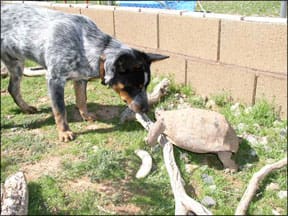
That’s why changing the dog’s emotional response is a much more effective way to modify his behavior than yelling at him, or asking him to perform an operant behavior. When his emotions are under control, then he can sit when you ask him to, but not before that. The sequence of events that is most likely to produce effective counter-conditioning is this:
1. Stimulus (cat) appears at sub-threshold distance, which is the distance at which the dog sees the cat and becomes alert but doesn’t start barking and lunging.
2. Owner begins feeding bits of high value treats to the dog as long as the cat is in view near threshold distance. (I like to use chicken for this as it is very high value for most dogs).
3. Cat disappears from view.
4. Owner stops feeding treats.
5. Repeat these four steps until when the cat appears, your dog looks at you with a big “Where’s my chicken?” grin on his face. We call this a “conditioned emotional response” or CER. When you have a consistent CER at your starting distance, you can decrease the distance slightly and repeat steps 1 through 4. Every time you obtain consistent CERs you can increase the intensity of the stimulus – bring the cat closer, have the cat move a little faster, introduce two cats . . .

The process of changing the association from inappropriate to appropriate is the counter-conditioning part. Increasing intensity of stimulus is the desensitization part. Done well, you end up with a dog and cat (or chinchilla, parrot, snake, tarantula) living safely together, just like Dubhy and Viva.
Combined Approach
Despite our stunning success in a very short time – who says positive methods take longer? – we continued to manage Dubhy with Viva by keeping them in separate rooms when we weren’t home to directly supervise, until the baby cat was six months old and better able to fend for herself. Viva’s healthy presence in our lives today is testimony to the effectiveness of our management and modification efforts.
Dubhy hasn’t lost one whit of his terrier gameness, however, as demonstrated recently. We share our farm with a fair number of black snakes, which is more than fine with me. I actually love snakes, and they are a big help with our resident wild rodent population. A few weeks ago I heard a Scottie commotion in the backyard while I was cleaning stalls in the barn. By the time I arrived to see what the fuss was about he had, much to my dismay, killed a six-foot black snake that was crossing the yard. Guess I won’t be keeping any snakes as pets in the near future!
If you combine basic good manners training with your program of counter-conditioning and desensitization you’re even further ahead. The better you and your dog can communicate to each other, the more effectively you’ll be able to control his behavior when the need arises.
Lucy, our Cardigan Corgi, is also fond of chasing cats, albeit from the herding dog “Whee, it’s fun to chase and round up things that move!” perspective rather from the terrier “KILL!” motivation. Although her motive is gentler, she is still capable of making the cats’ lives miserable. Counter-conditioning worked for her as well, but while Dubhy has completely given up any “kill” association with Viva, Lucy still yearns to chase our cats when they move. Her well-practiced “leave-it,” “come,” and “down” cues give us an added layer of insulation against inappropriate cat tormenting.
Carefully Orchestrated Introductions
Your chances of a successful multi-species relationship are best if you plan their introductions carefully. It’s rarely wise, although it sometimes works, to simply march in with a new family member and, in essence, “throw her to the wolves.” Far better to have both or all) nonhuman family members safely restrained and have the introduction be a positive classical conditioning experience or counter-conditioning if one or more of the participants have some prior association with the other’s species).
Here’s an example of a well-orchestrated introduction. For other species, substitute “other” for “cat” and figure out how to alter the process as appropriate. For example, “snake in tank” rather than carrier, and at some point human would hold the snake, rather than releasing her to roam around freely. Depending on participants, the processes described could take several weeks, or could occur all in one session.
PARTICIPANTS: Dog and Cat, 2 Humans
– Have cat in carrier.
– Place carrier on floor on far side of room.
– Enter with one dog on leash.
– Do classical conditioning (feed treats!) with both dog and cat at subthreshold distance until both are offering conditioned emotional responses (CERs) in the presence of the other.
– Decrease distance between dog and cat and repeat process to obtain CERs.
– When both are comfortable when the dog is in close proximity to the cat in her crate, return to the original distance and remove the cat from crate (but keep her restrained, ideally on harness and leash).
– Repeat CC&D process until dog and cat are comfortable in close proximity, both restrained.
– Return to original distance and release cat (dog is still restrained).
You will find that some species are more difficult to incorporate in the process as anything more than a silent presence. Because of the feeding habits of snakes, for example, it would be difficult to do CC&D with a snake as the dog enters the room and approaches the snake’s tank. In this case you may just have to settle for desensitization (becoming accustomed to the increasing intensity of the stimulus — the dog) without the classical conditioning (association) part.
Rehoming
There may come a time when you decide that it’s in the best interests of all concerned to remove one or more species from your household. This is a painful decision for any animal lover – and a very selfless one. It’s not easy to put the welfare of your cat, hamster, or cockatiel above your own emotional connection and feelings of commitment and responsibility. You may feel guilty that you perhaps haven’t done as much to make the situation work as you could – or should – have.
But with someone’s life is at risk, rehoming really is the best choice. This will give the at-risk pet a better chance for a long and happy life and remove much stress from your own home, thereby improving the quality of life for all your remaining family members, including yourself.
There must be millions of successful multi-species households, so chances are good that if you put your mind to it, you can make it work for yours. Take time to make wise adoption choices, orchestrate careful introductions, implement good management and training programs. If you do all this, you will likely succeed in your desire to turn your home into a peaceable kingdom, where lions lie down with lambs – or at least cats and dogs can live peacefully with canaries, rabbits, and boa constrictors.
Pat Miller, CBCC-KA, CPDT-KA, is Whole Dog Journal’s Training Editor. Miller lives in Hagerstown, Maryland, site of her Peaceable Paws training center. She is also the author of The Power of Positive Dog Training and Positive Perspectives: Love Your Dog, Train Your Dog.





